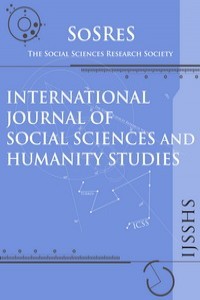AN EMPIRICAL ANALYSIS ON DETERMINANTS OF FOOD SECURITY AMONG FEMALE-HEADED HOUSEHOLDS IN SOUTH AFRICA
AN EMPIRICAL ANALYSIS ON DETERMINANTS OF FOOD SECURITY AMONG FEMALE-HEADED HOUSEHOLDS IN SOUTH AFRICA
___
- Akinloye, O., Putuma, M., & Adeyefa, S. A. (2016). Determinants of Food Insecurity among the Urban Poor in the City of Tshwane , South Africa, 4(2), 101–114. https://doi.org/10.15640/jeds.v4n2a9 Alsan, M., Xing, A., Wise, P., Darmstadt, G. L., & Bendavid, E. (2017). Childhood Illness and the Gender Gap in Adolescent Education in Low- and Middle-Income Countries. Pediatrics, 140(1), e20163175. https://doi.org/10.1542/peds.2016-3175 Arene, C. J. (2010). Determinants of Food Security among Households in Nsukka Metropolis of Enugu State , Nigeria, 30(1), 9–16. Bilinsky, P., & Swindale, A. (2006). Household Dietary Diversity Score ( HDDS ) for Measurement of Household Food Access : Indicator Guide VERSION 2 Anne Swindale Household Dietary Diversity Score ( HDDS ) for Measurement of Household Food Access : Indicator Guide VERSION 2. Chant, S. (2008). The “Feminisation of Poverty” and the “Feminisation” of Anti-Poverty Programmes: Room for Revision? Journal of Development Studies, 44(2), 165–197. https://doi.org/10.1080/00220380701789810 Chant, S. H. (2006). LSE Research Online Working paper Female household headship and the feminisation of poverty : facts, fictions and forward strategies. Doke, P. P. (2015). Gender issues in health sector. Journal of Krishna Institute of Medical Sciences University, 4(2), 10–18. Dunga, S. H. (2014). Determinants of Employment Status and Its Relationship to Poverty in Bophelong Township. Mediterranean Journal of Social Sciences, 5(21), 215–220. https://doi.org/10.5901/mjss.2014.v5n21p215 Dunga, S. H., & Grobler, W. (2017). The nexus of food and housing insecurity in South Africa. International Journal Of Social Sciences And Humanity Studies, 9(2), 95–108. FAO. (2006). Food Security definition, (2), 1–4. FAO. (2013). Food security and Nutrition in the Southern and Eastern rim of the Mediterranean basin. (M. Smulders, M. Aw-Dahir, K. Dunn, & R. Verduijn, Eds.). Field, A. (2009). Discovering Statistics using SPSS (3RD EDITIO). CALIFORNIA: THOUSAND OAKS. Hoddinott, J. & Yohannes, Y. (2002). Dietary diversity as a food security indicator. Washington, DC: International Food Policy Research Institute. Institute, P. H. (2016). Food Security, Climate Change, and Health. Public Health Institute. Retrieved from http://climatehealthconnect.org/wp-content/uploads/2016/09/FoodSecurity.pdf Labadarios, D., Mchiza, Z. J., Steyn, N., & Gericke, G. (2011). Food security in South Africa : a review of national surveys, (December). https://doi.org/10.1590/S0042-96862011001200012 Mncayi, N. P., & Dunga, S. H. (2017). Determinants of Housing Insecurity in a low income. International Journal of Economics And Finance Studies, 9(2), 117–133. Ngema, P. Z., Sibanda, M., & Musemwa, L. (2018). Household Food Security Status and Its Determinants in Maphumulo Local Municipality , South Africa, 1–23. https://doi.org/10.3390/su10093307 Ngoma, C., & Mayimbo, S. (2017). The Negative Impact of Poverty on the Health of Women and Children. Annals of Medical and Health Sciences Research, 7, 442–446. Psaki, S. R., McCarthy, K. J., & Mensch, B. S. (2018). Measuring Gender Equality in Education: Lessons from Trends in 43 Countries. Population and Development Review, 44(1), 117–142. https://doi.org/10.1111/padr.12121 STATS SA (2019) The extent of food security in South Africa. http://www.statssa.gov.za/ Accessed 7/22/2019 The World Bank. (2018). Poverty and Shared ProsperityEMPIRICAL 2018: Piecing together the poverty puzzle. https://doi.org/10.1596/978-1-4648-0958-3 United Nations. (1975). World Food Conference report, (November), 5–16. United Nations. (2018). The Sustainable Development Goals Report: 2018. United nations. New York. https://doi.org/10.11260/kenkokyoiku.19.77 Walsh, C. M., Rooyen, F. C. Van, & Walsh, C. M. (2015). Household Food Security and Hunger in Rural and Urban Communities in the Free State Province , South Africa Household Food Security and Hunger in Rural and Urban Communities in the Free State Province , South Africa, 0244. https://doi.org/10.1080/03670244.2014.964230
- Başlangıç: 2009
- Yayıncı: Sosyal Bilimler Araştırmaları Derneği
Mdumiso MAZİBUKO, Nobukhosi DLODLO
DECOLONISING THE SOUTH AFRICAN HIGHER EDUCATION CURRICULUM: AN INVESTIGATION INTO THE CHALLENGES
EVALUATING THE ROLE OF CRIMINAL INVESTIGATORS DURING BAIL APPLICATION
Mokwena RJ, Motseki MM, Dube NC
PERCEIVED BARRIERS TO EMPLOYMENT: A CASE OF FEMALE HOUSEHOLD HEADS IN A SOUTH AFRICAN TOWNSHIP
Tebello Hilda MSİMANGA, Tshediso Joseph SEKHAMPU
THE AFRICAN SCARE OF FALL ARMYWORM: ARE SOUTH AFRICAN FARMERS IMMUNE?
Pj VAN SCHALKWYK, Ayesha Lian BEVAN-DYE
Angelita KİTHATU-KİWEKETE, Sean PHİLLİPS
ANALYSIS OF THE NON-LINEAR EFFECT OF PETROL PRICE CHANGES ON INFLATION IN SOUTH AFRICA
